- Sign In
- |
- Sign Up
- |
- My Quote (0)
- |
- CART (0)
Effortlessly integrate infrared data, images, and videos with this fixed-mount infrared camera that features a 320 x 240 resolution and provides comprehensive research analysis. With a 1.85 mRad spatial resolution, this camera is ideal for research, science and engineering and comes complete with SmartView® desktop software.
Effortlessly integrate infrared data, images, and videos with this fixed-mount infrared camera that features a 320 x 240 resolution and provides comprehensive research analysis. With a 1.85 mRad spatial resolution, this camera is ideal for research, science and engineering and comes complete with SmartView® desktop software.
Discontinued!
This product has been discontinued and is no longer available.
This is the direct replacement:
MATLAB® and LabVIEW® software compatibility allows users to integrate infrared data, images and videos to support R&D analysis
Features
Applications
When conducting infrared inspections, high-quality images that allow for better analysis, presentation, and professionalism are essential.
With a sharply focused image, there is a distinct contrast between areas of varying thermal energy on the surface being inspected. This allows the individual detector elements (also known as pixels) to clearly report the intensity of the energy being focused on them.
When the focus is poor, the incoming energy isn't as concentrated on individual detectors, and their response is skewed. This can lead to temperature measurements that are significantly off, resulting in expensive downtime and possible safety hazards.
Thermal imagers are made with 100% diamond-turned germanium lenses covered with a specialty coating, providing premium quality images.



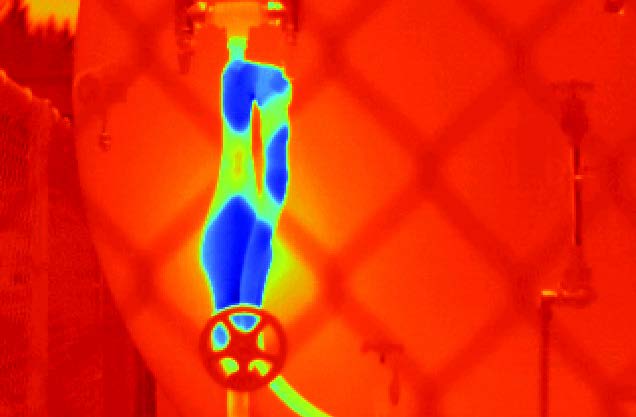
LaserSharp Auto Focus allows you to select and focus on a specific target
Easily choose and focus on your target
LaserSharp™ Auto Focus uses a built-in laser distance meter that provides both speed and precision. The laser-driven target detection pinpoints the target while the camera focuses to capture a precise, high-quality image. With LaserSharp Auto Focus, you can:
Choose multiple targets at different distances
MultiSharp™ Focus takes multiple images from different focal distances and combines them into one clear image. With a simple point and shoot, you can go from being completely out of focus, to complete focus, throughout the field of view. With MultiSharp:
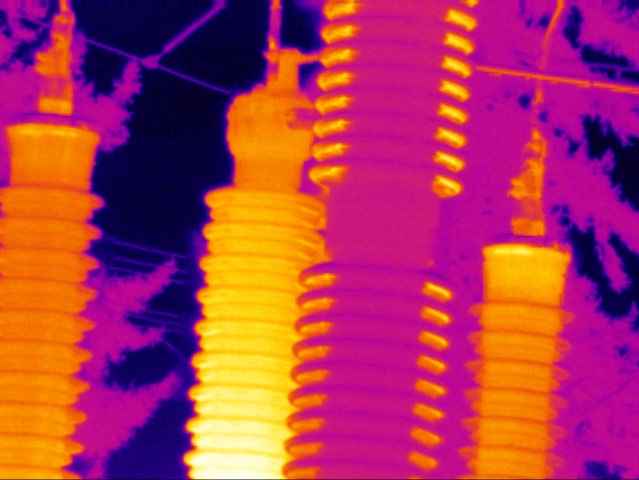

1.Middleground in focus

2.Foreground in focus

3.Background in focus
Shoot from a distance
Infrared inspections can take you into multiple types of environments with many types of equipment. Interchangeable lenses that require no calibration give you the versatility and the image quality needed to conduct inspections in almost any environment.
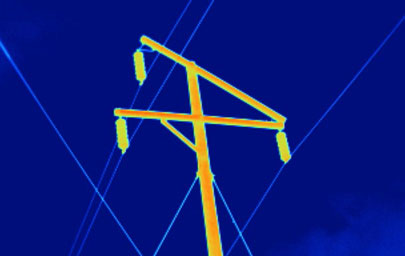
High voltage power pole, captured with a TiX560 camera and standard lens
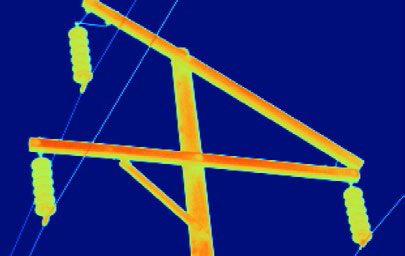
The same power pole captured from the same distance, but with a 2x telephoto lens
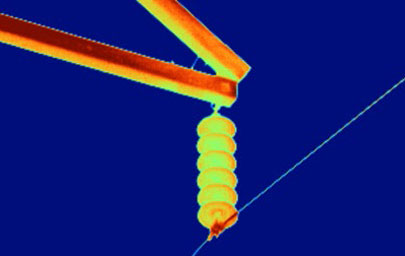
The same power pole captured from the same distance, but with a 4x telephoto lens
Whether you are troubleshooting or conducting maintenance inspections, having easy access to more information faster is always a big benefit.
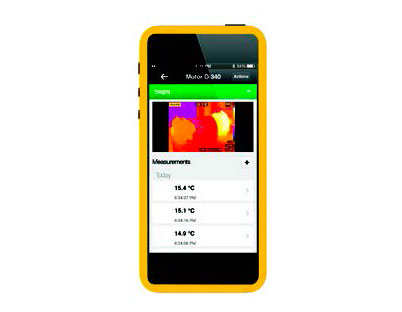
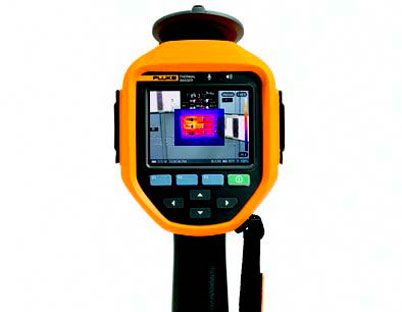
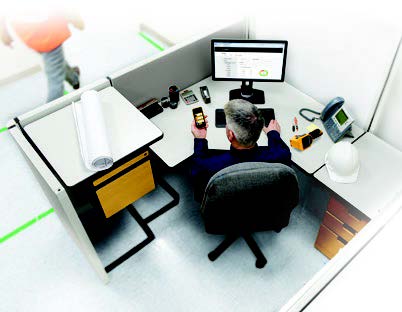
Document information on the equipment you're inspecting
With IR PhotoNotes™, voice or text annotation, you can easily document critical information about each piece of equipment and its location. Each "note" attaches to the image, so you never have to search or match up notes to images.
 |
 |
Image Info | |
| IR Sensor Size | 320 x 240 |
| Distance to Target | 0.69 m |
Main Image Markers | |
| Name | Temperature |
| Centerpoint | 29.1°C |
Capture digital and infrared images at once
IR Fusion™ technology combines visible light and an infrared image into one, giving you better clarity.
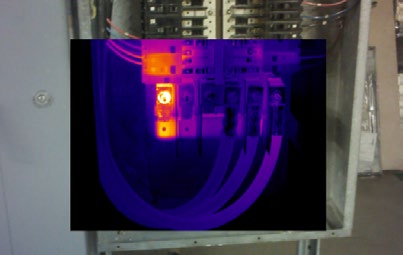
IR Fusion picture-in-picture mode: Ironbow palette
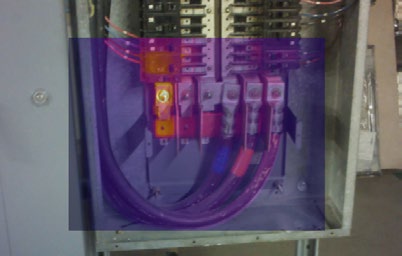
IR Fusion picture-in-picture mode: AutoBlend
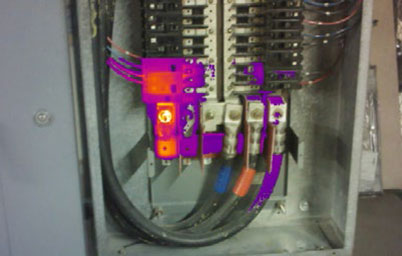
IR Fusion color alarm
Seven benefits of on-site infrared inspections
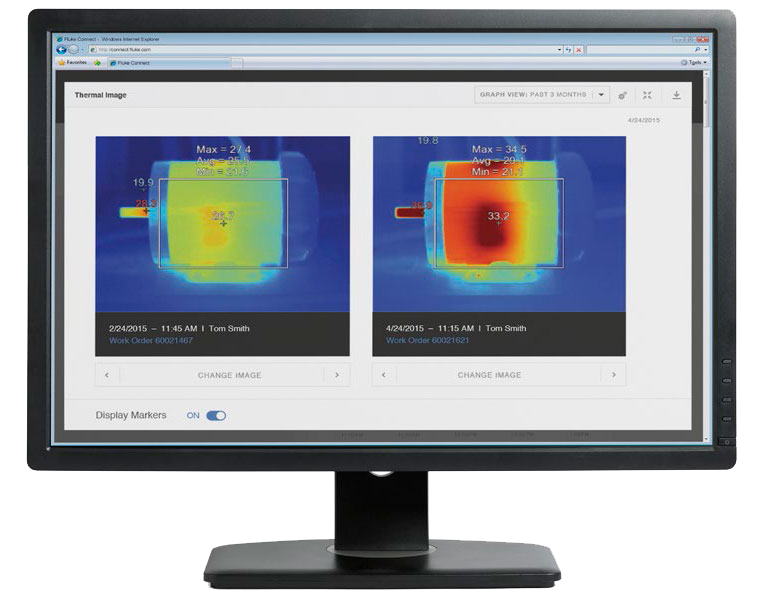
Review thermal images side by side, making it easy to compare today's reading with the baseline or other historical images.
| Detector Resolution | 320 x 240 (76,800 pixels) |
| IFOV with Standard Lens (Spatial Resolution) | 1.85 mRad |
| Field of View | 34° x 25.5° |
| Minimum Focus Distance | 15 cm (6") |
| Thermal Sensitivity (NETD) | ≤0.030°C at 30°C Target Temperature (30 mK) |
| Frame Rate | 60 Hz or 9 Hz Versions |
| Temperature Measurement Range (Not Calibrated Below -10°C) | 14 to 2192°F (-10 to 1200°C) |
| Accuracy | ±2°C or ±2%, Whichever is Greater |
| Operating Temperature | 14 to 122°F (-10 to 50°C) |
| Dimensions | 8.3 x 8.3 x 16.5 cm (3.3 x 3.3 x 6.5") |
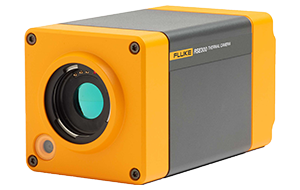
|
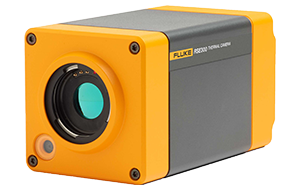
|
|
| Model | Fluke RSE600 | Fluke RSE300 |
|---|---|---|
| Infrared resolution | 640 x 480 (307,200 pixels) | 320 x 240 (76,800 pixels) |
| IFOV (spatial resolution) |
0.93 mRad | 1.85 mRad |
| Field of view | 34°H x 24°V | 34°H x 24°V |
| Thermal sensitivity* | ≤ 0.040 at 30°C target temp (40 mK)* | ≤ 0.030 at 30°C target temp (30 mK)* |
| Temperature range | 14 to +2192°F (-10 to +1200°C) | 14 to +2192°F (-10 to +1200°C) |
| Focus systems | Focus is adjusted in Fluke Connect Desktop software (manual or MultiSharp™) | |
| Laser distance meter | ||
| Optional lenses | Pre-calibrated smart lenses: wide angle, 2x telephoto, 4x telephoto, macro | |
| Wireless connectivity** | ||
| IR-Fusion® | Yes, in Fluke Connect Desktop software. Five modes of image blending (AutoBlend™ mode, Picture-in-Picture (PIP), IR/Visible alarm, Full IR, Full visible light) add the context of the visible details to your infrared image |
|
| Display | ||
| Design | Can be mounted to a stand or wall bracket for continuous data streaming | |
| Frame rate | 60 or 9 Hz versions | 60 or 9 Hz versions |
| Software | Fluke Connect Desktop software—full analysis and reporting
software Compatible with MATLAB® and LabVIEW® software |
|
| Voice annotation | Yes, in Fluke Connect Desktop software | |
| Text annotation | Yes, in Fluke Connect Desktop software | |
| Video recording | Radiometric, in Fluke Connect Desktop software, with exports to standard non-radiometric formats | |
| Streaming video (remote display) |
Yes, see the live stream of the camera on your PC, smartphone, or TV monitor. Via USB, WiFi hotspot, or WiFi network to Fluke Connect Desktop software on a PC; via WiFi hotspot to the Fluke Connect™ app |
|
| Remote control operation | Yes, through ethernet or Fluke Connect Desktop software | |
| Alarms | Yes, in Fluke Connect Desktop software–high temperature
low temperature, and isotherms (within range) |
|
| Warranty | Two-years (standard), extended warranties are available | |
*Best possible **Fluke Connect™ not available in all countries
Whether you choose a simple point-and-shoot model or a high-end thermal imager with all the bells and whistles, here are some key features and specs you should consider:
With a variety of focus mechanisms to choose from, it is important to take into account your skill level as well as the application in selecting a focus type. Here are the common focus mechanisms:

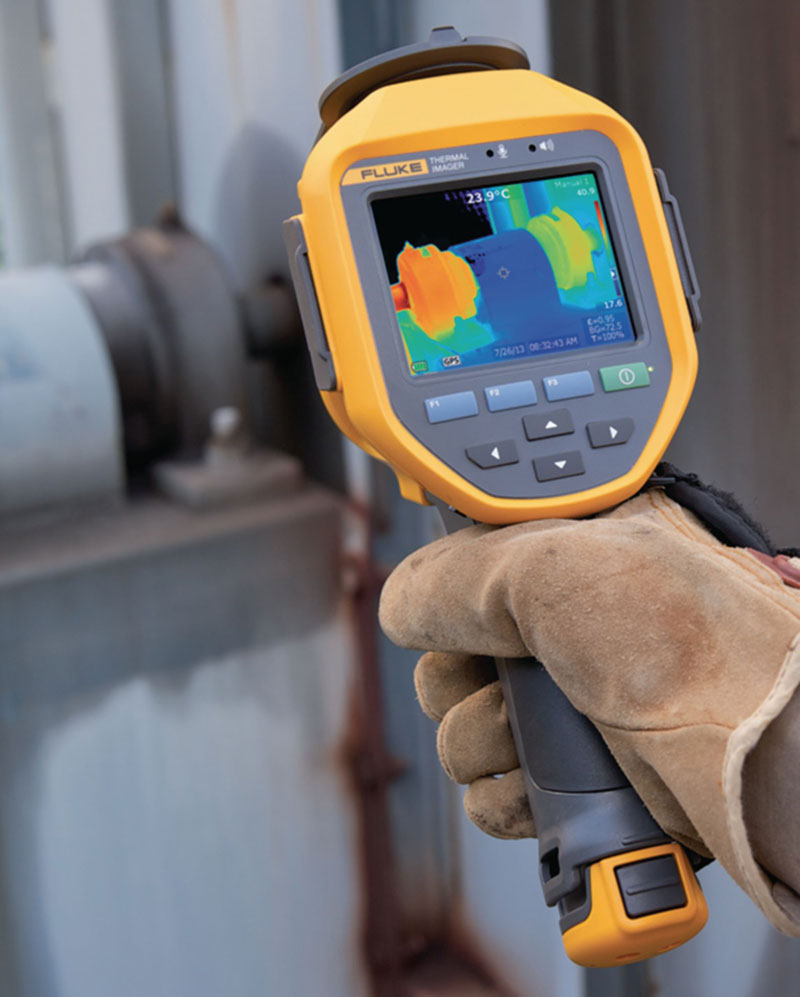
The highest and lowest temperature you encounter in your inspection determines the temperature range you need from your thermal imager. Or, select a camera with a wide temperature range that automatically selects the range based on your scene, or allows you to manually select the temperature range.
A camera that lets you change lenses increases your versatility, allowing you to inspect many more types of equipment and situations. There are lots of choices for lots of applications—standard, wide angle, telephoto, and macro.
Save infrared and digital images and in some cases voice notes to internal memory, a removable SD card, or to a USB flash drive. It’s important to have the flexibility to save images and additional related data to different media for backup or sharing.
Slight differences are easier to see with a monochromatic palette, such as grayscale or amber. High contrast palettes can make it easier to quickly find obvious anomalies. You should be able to change the palette in the camera or in the software.
Use these to quickly highlight areas outside your normal temperature ranges.
Low emissivity surfaces, such as shiny metals, can reflect infrared energy from other objects and throw off your image and your measurement accuracy. So, look for the option to adjust parameters when choosing an imager.
Mark specific temperatures on your image to compare simultaneous temperatures from multiple points on the same image.
Look for a battery with useful features such a charge level indicator. Nothing is worse than starting an inspection with no idea of the battery status. Also consider long battery life and quick charging ability.
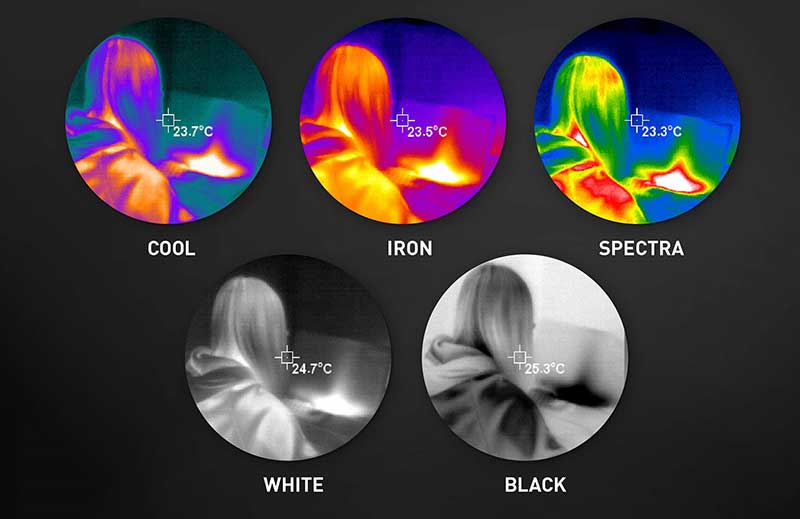
Check out the different color palettes available on your thermal imager!
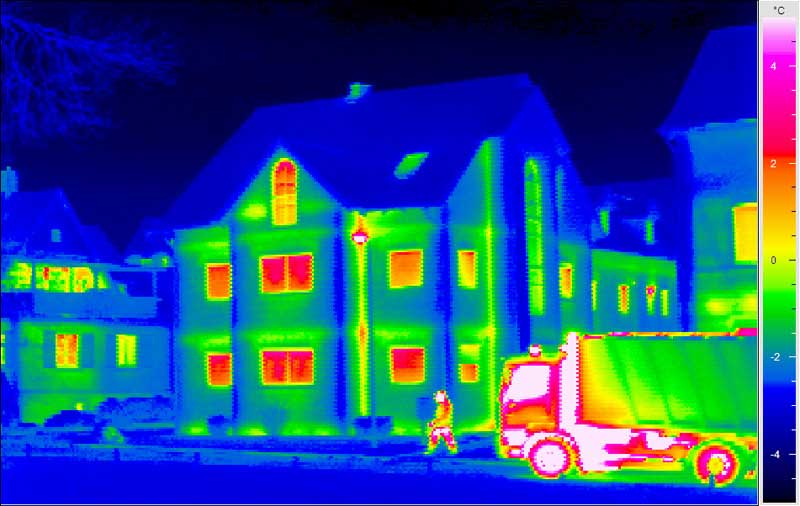
View your home through the eyes of a thermal imager and and see where the hot and cold spots are.
By Sat Sandhu, Fluke
Electronic circuits and components come in a variety of shapes and forms. All electronics operate with current flowing, which in turn leads to power dissipation. This power dissipation manifests itself primarily in the form of heat. Hence a key factor in the design, tests, verification and troubleshooting of all electronics, is heat management. With increasing circuit complexity and or reduction in size, heat management of electronics is taking on a more significant role in the design phase and also in the subsequent phases of test, verification and troubleshooting.
Thermal imaging cameras (TI) are an ideal tool to use in mapping out the heat patterns on electronic circuits and components. Two major advantages of Thermal imaging over contact temperature measurement devices are:
If you would like to learn more about:
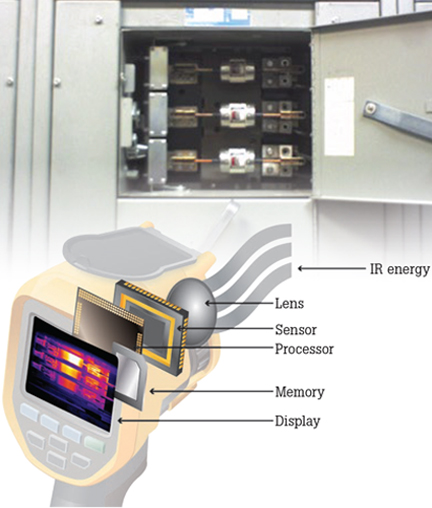
Detailed anatomy of an infrared camera
By Sat Sandhu, Fluke
Infrared cameras, also called thermal imagers, are useful for troubleshooting motor problems as well as for monitoring motor condition for preventative maintenance in power generation, manufacturing and commercial plants. Thermal images of motors reveal their operating condition as indicated by surface temperature. Such condition monitoring is important as a way to avert many unexpected motor malfunctions in systems that are critical to manufacturing.
The onset of motor failures can often be detected by a variety of techniques, including vibration, ultrasound and thermal imaging.
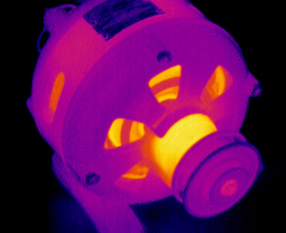
Thermal image of machinery
Why thermal imaging?
Thermal imaging is an effective way to assess equipment condition. Thermal imaging enables you to:
What to scan?
To get started in building heat profiles of your motors, it is a best practice to capture good quality infrared images when the motors are running under normal operating conditions. That gives you baseline measurements of the temperature of components. An infrared camera can capture temperatures of all the critical components: motor, shaft coupling, motor and shaft bearings, and the gearbox.
When you are working with low electrical loads, the indications of a problem may be subtle. Thus a minimum of 40% of design load is recommended (National Fire Protection Association NFPA 70B), and the higher the load, the better. When inspecting in low load situations, be sure to note all possible problems, even if they reflect only a small temperature difference. As a load increases, the temperature will increase too and if a problem exists, expect greater temperature differences at higher loads.
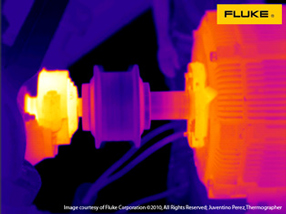
Coupling: This image shows an alignment issue on a motor coupling.
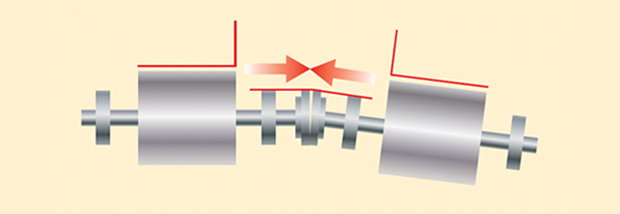
Angular misalignment
The centerline of the two shafts intersect are not parallel.
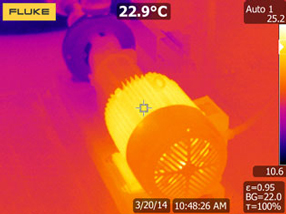
Combo: This heat pattern indicates an operational motor.
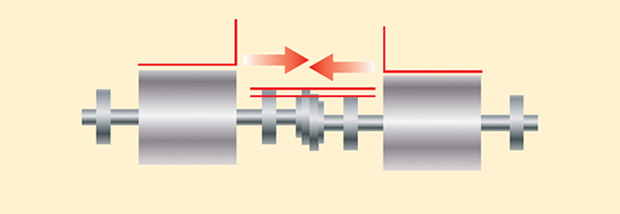
Parallel misalignment
The centerline of the two shafts are parallel but not concentric.
All motors should list the normal operating temperature on the nameplate. Abnormal temperatures, which will show up on a thermal imaging inspection, can be an indication of:
Inadequate cooling because of insufficient air flow. Clearing this issue may only require minor cleaning on the air intake grills.
Power quality issues such as unbalanced voltage or overload or harmonics. All of these will cause excessive heat dissipation.
Impending bearing failure. An overheating bearing is an indication of an impending bearing failure. Bearing condition degrade for a number of reasons:
Insulation failure. With failing insulation of the motor windings the overall motor temperature increases this overheating causes failures and reduces insulation time.
Shaft misalignment. Most misalignment cases are a combination of parallel and angular misalignment (see images above).
Creating regular inspection routes that include thermal images of all critical motor/drive combinations and tracking to those baseline images will help you determine whether a hotspot is unusual or not, and help you verify if the repairs were successful.
Click on a category to view a selection of compatible accessories with the Fluke RSE300 Infrared Camera, 60 Hz, 320 x 240.
| Detector Resolution | 320 x 240 (76,800 pixels) |
| IFOV with Standard Lens (Spatial Resolution) | 1.85 mRad |
| Field of View | 34° x 25.5° |
| Minimum Focus Distance | 15 cm (6") |
| Thermal Sensitivity (NETD) | ≤0.030°C at 30°C Target Temperature (30 mK) |
| Frame Rate | 60 Hz or 9 Hz Versions |
| Temperature Measurement Range (Not Calibrated Below -10°C) | 14 to 2192°F (-10 to 1200°C) |
| Accuracy | ±2°C or ±2%, Whichever is Greater |
| Operating Temperature | 14 to 122°F (-10 to 50°C) |
| Dimensions | 8.3 x 8.3 x 16.5 cm (3.3 x 3.3 x 6.5") |

|

|
|
| Model | Fluke RSE600 | Fluke RSE300 |
|---|---|---|
| Infrared resolution | 640 x 480 (307,200 pixels) | 320 x 240 (76,800 pixels) |
| IFOV (spatial resolution) |
0.93 mRad | 1.85 mRad |
| Field of view | 34°H x 24°V | 34°H x 24°V |
| Thermal sensitivity* | ≤ 0.040 at 30°C target temp (40 mK)* | ≤ 0.030 at 30°C target temp (30 mK)* |
| Temperature range | 14 to +2192°F (-10 to +1200°C) | 14 to +2192°F (-10 to +1200°C) |
| Focus systems | Focus is adjusted in Fluke Connect Desktop software (manual or MultiSharp™) | |
| Laser distance meter | ||
| Optional lenses | Pre-calibrated smart lenses: wide angle, 2x telephoto, 4x telephoto, macro | |
| Wireless connectivity** | ||
| IR-Fusion® | Yes, in Fluke Connect Desktop software. Five modes of image blending (AutoBlend™ mode, Picture-in-Picture (PIP), IR/Visible alarm, Full IR, Full visible light) add the context of the visible details to your infrared image |
|
| Display | ||
| Design | Can be mounted to a stand or wall bracket for continuous data streaming | |
| Frame rate | 60 or 9 Hz versions | 60 or 9 Hz versions |
| Software | Fluke Connect Desktop software—full analysis and reporting
software Compatible with MATLAB® and LabVIEW® software |
|
| Voice annotation | Yes, in Fluke Connect Desktop software | |
| Text annotation | Yes, in Fluke Connect Desktop software | |
| Video recording | Radiometric, in Fluke Connect Desktop software, with exports to standard non-radiometric formats | |
| Streaming video (remote display) |
Yes, see the live stream of the camera on your PC, smartphone, or TV monitor. Via USB, WiFi hotspot, or WiFi network to Fluke Connect Desktop software on a PC; via WiFi hotspot to the Fluke Connect™ app |
|
| Remote control operation | Yes, through ethernet or Fluke Connect Desktop software | |
| Alarms | Yes, in Fluke Connect Desktop software–high temperature
low temperature, and isotherms (within range) |
|
| Warranty | Two-years (standard), extended warranties are available | |
*Best possible **Fluke Connect™ not available in all countries
Whether you choose a simple point-and-shoot model or a high-end thermal imager with all the bells and whistles, here are some key features and specs you should consider:
With a variety of focus mechanisms to choose from, it is important to take into account your skill level as well as the application in selecting a focus type. Here are the common focus mechanisms:


The highest and lowest temperature you encounter in your inspection determines the temperature range you need from your thermal imager. Or, select a camera with a wide temperature range that automatically selects the range based on your scene, or allows you to manually select the temperature range.
A camera that lets you change lenses increases your versatility, allowing you to inspect many more types of equipment and situations. There are lots of choices for lots of applications—standard, wide angle, telephoto, and macro.
Save infrared and digital images and in some cases voice notes to internal memory, a removable SD card, or to a USB flash drive. It’s important to have the flexibility to save images and additional related data to different media for backup or sharing.
Slight differences are easier to see with a monochromatic palette, such as grayscale or amber. High contrast palettes can make it easier to quickly find obvious anomalies. You should be able to change the palette in the camera or in the software.
Use these to quickly highlight areas outside your normal temperature ranges.
Low emissivity surfaces, such as shiny metals, can reflect infrared energy from other objects and throw off your image and your measurement accuracy. So, look for the option to adjust parameters when choosing an imager.
Mark specific temperatures on your image to compare simultaneous temperatures from multiple points on the same image.
Look for a battery with useful features such a charge level indicator. Nothing is worse than starting an inspection with no idea of the battery status. Also consider long battery life and quick charging ability.

Check out the different color palettes available on your thermal imager!

View your home through the eyes of a thermal imager and and see where the hot and cold spots are.
By Sat Sandhu, Fluke
Electronic circuits and components come in a variety of shapes and forms. All electronics operate with current flowing, which in turn leads to power dissipation. This power dissipation manifests itself primarily in the form of heat. Hence a key factor in the design, tests, verification and troubleshooting of all electronics, is heat management. With increasing circuit complexity and or reduction in size, heat management of electronics is taking on a more significant role in the design phase and also in the subsequent phases of test, verification and troubleshooting.
Thermal imaging cameras (TI) are an ideal tool to use in mapping out the heat patterns on electronic circuits and components. Two major advantages of Thermal imaging over contact temperature measurement devices are:
If you would like to learn more about:

Detailed anatomy of an infrared camera
By Sat Sandhu, Fluke
Infrared cameras, also called thermal imagers, are useful for troubleshooting motor problems as well as for monitoring motor condition for preventative maintenance in power generation, manufacturing and commercial plants. Thermal images of motors reveal their operating condition as indicated by surface temperature. Such condition monitoring is important as a way to avert many unexpected motor malfunctions in systems that are critical to manufacturing.
The onset of motor failures can often be detected by a variety of techniques, including vibration, ultrasound and thermal imaging.

Thermal image of machinery
Why thermal imaging?
Thermal imaging is an effective way to assess equipment condition. Thermal imaging enables you to:
What to scan?
To get started in building heat profiles of your motors, it is a best practice to capture good quality infrared images when the motors are running under normal operating conditions. That gives you baseline measurements of the temperature of components. An infrared camera can capture temperatures of all the critical components: motor, shaft coupling, motor and shaft bearings, and the gearbox.
When you are working with low electrical loads, the indications of a problem may be subtle. Thus a minimum of 40% of design load is recommended (National Fire Protection Association NFPA 70B), and the higher the load, the better. When inspecting in low load situations, be sure to note all possible problems, even if they reflect only a small temperature difference. As a load increases, the temperature will increase too and if a problem exists, expect greater temperature differences at higher loads.

Coupling: This image shows an alignment issue on a motor coupling.

Angular misalignment
The centerline of the two shafts intersect are not parallel.

Combo: This heat pattern indicates an operational motor.

Parallel misalignment
The centerline of the two shafts are parallel but not concentric.
All motors should list the normal operating temperature on the nameplate. Abnormal temperatures, which will show up on a thermal imaging inspection, can be an indication of:
Inadequate cooling because of insufficient air flow. Clearing this issue may only require minor cleaning on the air intake grills.
Power quality issues such as unbalanced voltage or overload or harmonics. All of these will cause excessive heat dissipation.
Impending bearing failure. An overheating bearing is an indication of an impending bearing failure. Bearing condition degrade for a number of reasons:
Insulation failure. With failing insulation of the motor windings the overall motor temperature increases this overheating causes failures and reduces insulation time.
Shaft misalignment. Most misalignment cases are a combination of parallel and angular misalignment (see images above).
Creating regular inspection routes that include thermal images of all critical motor/drive combinations and tracking to those baseline images will help you determine whether a hotspot is unusual or not, and help you verify if the repairs were successful.
Click on a category to view a selection of compatible accessories with the Fluke RSE300 Infrared Camera, 60 Hz, 320 x 240.